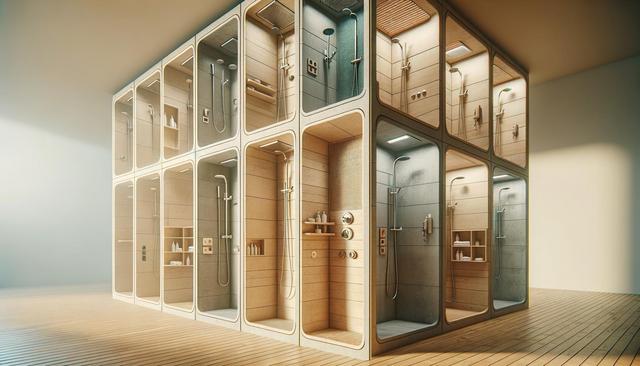What Is a Prefab Shower?
Prefab showers, short for prefabricated showers, are pre-manufactured shower units that come in complete kits or modular pieces. These units are designed for quick and easy installation, making them a convenient choice for homeowners looking to upgrade their bathrooms without the complexities of a full custom-built shower. Typically made from materials like fiberglass, acrylic, or composite plastics, prefab showers are molded into shape and finished with a smooth, water-resistant surface. They are available in a range of styles, sizes, and configurations to suit various bathroom layouts and user needs.
Prefab showers are commonly categorized into two types: single-piece units and multi-piece kits. Single-piece units are ideal for new construction projects where the unit can be easily maneuvered into place before walls are closed. Multi-piece kits, on the other hand, are designed for remodeling projects and can be assembled inside an existing bathroom, even if access is limited. This versatility, combined with their cost-effectiveness, has made prefab showers a popular option for both DIY renovators and professional contractors.
Benefits of Choosing a Prefab Shower
There are numerous advantages to installing a prefab shower, making them a practical alternative to custom tile showers. First and foremost, prefab showers significantly reduce installation time. Since they are pre-molded and ready to install, they eliminate the need for time-consuming tasks like tiling, grouting, and waterproofing.
Some key benefits include:
- Lower overall costs compared to custom-built showers
- Ease of maintenance due to smooth, non-porous surfaces
- Quick installation, often within a day or two
- Consistent quality and durability
- Wide variety of styles and sizes to fit different bathroom layouts
In addition, prefab showers are designed with functionality in mind. Many models come with built-in shelves, grab bars, and seating options, which can be particularly helpful for accessibility needs. Their seamless design also reduces the chance of leaks and mold growth, contributing to a longer-lasting and healthier bathroom environment.
Materials and Design Options
When selecting a prefab shower, it’s important to consider the material as it affects durability, appearance, and price. Acrylic and fiberglass are among the most commonly used materials. Acrylic units are generally more durable and resistant to scratches and stains, while fiberglass options are lighter and often more affordable.
Some of the material choices include:
- Acrylic: Durable, glossy finish, easy to clean
- Fiberglass: Lightweight, cost-effective, decent durability
- Composite: Offers enhanced strength and insulation
Design-wise, prefab showers come in a range of configurations, from corner units to spacious walk-in enclosures. They may also include sliding or hinged doors, depending on the model. Color options are typically neutral—white, beige, or gray—but some manufacturers offer more contemporary finishes to match modern interiors. Whether you’re working with a compact powder room or a large master bath, there’s likely a prefab shower configuration that meets your spatial and aesthetic requirements.
Installation Considerations
Installing a prefab shower is generally straightforward, especially when using a multi-piece kit. However, there are a few important factors to keep in mind before beginning the installation. Measurement is critical—always ensure the unit will fit through doorways and can be positioned correctly within the bathroom space. Plumbing access and floor leveling are also essential to ensure a proper fit and function.
Key steps in the installation process include:
- Removing the existing shower or tub
- Checking and adjusting plumbing connections
- Ensuring the floor is level and clean
- Securing the shower base and wall panels
- Sealing all joints and testing for leaks
While many homeowners are comfortable handling the installation themselves, hiring a professional can ensure that plumbing and sealing are done correctly, particularly in older homes where plumbing may need upgrading. Additionally, local building codes may require certain permits or inspections, so it’s wise to consult with professionals before starting the project.
Maintenance and Longevity
One of the appealing aspects of prefab showers is their low maintenance requirement. Unlike tiled showers, which require regular grout cleaning and sealing, prefab units have fewer seams and non-porous surfaces that resist mold and mildew. Routine cleaning with mild, non-abrasive cleaners is typically sufficient to keep the shower looking fresh and hygienic.
To maximize the lifespan of your prefab shower, consider these maintenance tips:
- Wipe down surfaces regularly to prevent soap scum buildup
- Avoid harsh chemicals that could damage the finish
- Inspect seals and caulking periodically and reapply as needed
- Use shower mats or non-slip pads to protect the base
With proper care, a high-quality prefab shower can last for many years. It’s also worth noting that some models come with manufacturer warranties, offering additional peace of mind. By combining ease of maintenance with modern features and durable materials, prefab showers offer a long-term solution that balances functionality and aesthetic appeal.
Conclusion: A Smart Choice for Modern Bathrooms
Prefab shower options provide an efficient, affordable, and attractive alternative to traditional custom-built showers. Whether you’re renovating a dated bathroom or building a new one from scratch, these units offer a wide array of designs and configurations to meet diverse needs. With benefits like simplified installation, low maintenance, and reliable durability, they make an excellent choice for homeowners seeking both convenience and quality. By understanding the various materials, features, and installation requirements, you can confidently choose a prefab shower that enhances your bathroom space while staying within budget and timeline constraints.


